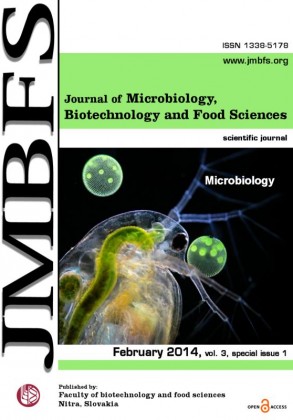COLONIZATION OF GRAPE BERRIES BY THE GENUS FUSARIUM AND TOXIGENITY OF THE MOST COMMON REPRESENTATIVES
Keywords:
Fusarium sp., grape berries, mycobiota, mycotoxinsAbstract
The aim of the study was to assess mycotoxin-producing fungi, especially from Fusarium genus, in grapes destined for wine production and to test the ability of selected Fusarium strains to produce mycotoxins as deoxynivalenol (DON), diacetoxyscirpenol (DAS), HT-2 (HT-2) toxin, T-2 (T-2) toxin and zearalenon (ZEA). Totally we processed 24 samples, collected from various Slovak localities in year 2012. The total and endogenous mycobiota was determined by the method of direct placing of grape berries on agar plates. Endogenous mycobiota was estimated after the superficial sterilization. The isolation frequency of the Fusarium genus was 83.3%, in the framework of the non-sterilized and also of sterilized berries. The average relative density was relatively low (2.2% - without sterilization, 2.3% - with sterilization). Totally we identified 11 species of the genus Fusarium. The most important species, on the basis of the isolation frequency and relative density, were F. proliferatum and F. sporotrichioides. Selected isolates of this two species were tested for their toxigenity, by means of thin-layer chromatography. Tests of F. proliferatum confirmed only sporadic production of diacetoxyscirpenol, HT-2 and T-2 toxins. Isolates of F. sporotrichioides have demonstrated high ability to produce diacetoxyscipenol, deoxynivalenol and T-2 toxin (100%), 73% produced HT-2 toxin and 50% synthesized zearalenon.Downloads
Download data is not yet available.
Downloads
Published
2014-02-01
How to Cite
MaÅ¡ková, Z., TanÄinová, D., Rybárik, ĽubomÃÂr, & Felšöciová, S. (2014). COLONIZATION OF GRAPE BERRIES BY THE GENUS FUSARIUM AND TOXIGENITY OF THE MOST COMMON REPRESENTATIVES. Journal of Microbiology, Biotechnology and Food Sciences, 3(special issue 1 (Microbiology), 256–258. Retrieved from https://office2.jmbfs.org/index.php/JMBFS/article/view/7613
Issue
Section
Microbiology
License
Copyright (c) 2014 Zuzana MaÅ¡ková, Dana TanÄinová, ĽubomÃÂr Rybárik, Soňa Felšöciová

This work is licensed under a Creative Commons Attribution 4.0 International License.
All papers published in the Journal of Microbiology, Biotechnology and Food Sciences are published under a CC-BY licence (CC-BY 4.0). Published materials can be shared (copy and redistribute the material in any medium or format) and adapted (remix, transform, and build upon the material for any purpose, even commercially) with specifying the author(s).

